Themes of drawing and digital context: student engagement with theory and practice using the tool of the integrated learning portfolio
Rowan Bailey, Andrew Taylor and Linda Lewis, University of Huddersfield
This article presents a reflective visual narrative documenting the learning encounters of BA (Hons) Surface Design undergraduates using the Integrated Learning Portfolio (ILP) tool in Year one. Theoretical themes of drawing, digital drawing design practice, and visual design research experientially blended the physical and the virtual learning tools, environments and collaborative culture thro...
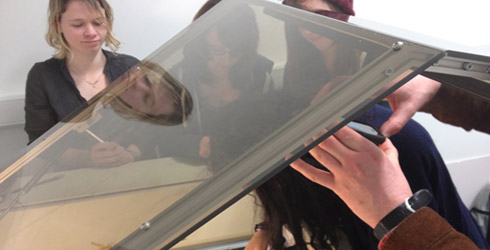
Keywords: theory and practice, reflection, drawing practices, digital contexts
Abstract
This article presents a reflective visual narrative documenting the learning encounters of BA (Hons) Surface Design undergraduates using the Integrated Learning Portfolio (ILP) tool in Year one. Theoretical themes of drawing, digital drawing design practice, and visual design research experientially blended the physical and the virtual learning tools, environments and collaborative culture through this integrated first year route. Parallel theory and practice on specific themes such as ‘drawing lines within the urban landscape’, ‘creating shadow silhouettes’, ‘using the body as a tool for drawing’, and ‘cultivating fortuitous accidents in drawing practice’, created a conceptual space for students to evaluate the future relevance of these drawing experiences within the context of their design programme.

Figure 1
Context and Rationale
The Integrated Learning Portfolio (ILP) is now a well-established tool used in the three specialist routes of Textile Design, Textile Art/Craft and Surface Design, which make up the Textiles Degree Programme at the University of Huddersfield. It was initially designed as a module that would enable first year students to take a more holistic and independent approach to their programme of study, by facilitating opportunities to identify and use different skills and practices, encouraging reflection on core areas of learning development, as well as establishing links between modules in different contexts and for different outcomes (Squires, Tinker and Redmore, 2009). Embedded within other theory and practice-led modules at various points throughout the year, the module enables students to think about what it is they are learning, and how they are implementing that learning into a variety of projects and modes of assessment.
The ILP is structured through two avenues of reflective enquiry: firstly, a learning journal, within which students are encouraged to consider their learning process throughout the year, by regularly blogging and documenting key moments of decision making and thinking about their design practice. Secondly, a portfolio of evidence which reflects areas of learning developed by each student on different modules, including the transferable links between them [see Table 1].
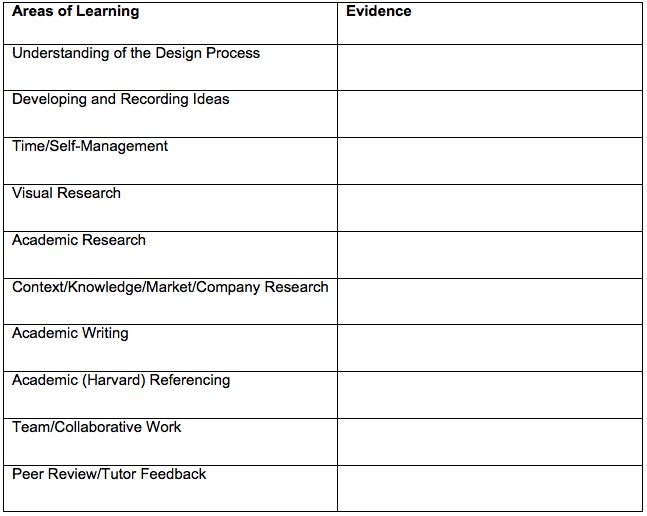
Table 1
At the end of the year, students submit a written reflective report of 2000 words, cross-referenced to this portfolio of evidence and reflective blog entries, inviting them to consider their progressive learning development. The report is assessed in terms of the student’s ability to select relevant evidence, discuss significant critical incidents, reflect on the year holistically, and articulate links between modules. As a module which is essentially student-led and self-directed, with staff signposts in the form of workshops at relevant points in terms one and two, student reflections are often illuminating, enriching and pleasantly surprising. However, what has been identified as a recurrent feature within these end-of-year reflective reports, is confusion when it comes to discussing possible links between modules. Most students identify the skills they have acquired and used, but their ability to reflect on the different forms these skills take, in different contexts, is often a struggle, and more often than not, neglected with a preference for presenting a compartmentalised appraisal of each area of learning and each module in isolation. This failure to contemplate learning experiences holistically and in a transferable way defeats the core objective of the ILP tool.
Having identified that this failure is a distinct feature of reflective difficulty for students, this academic year the team proposed to approach the ‘Visual Research’, ‘Theory in Context’ and ‘CAD for ILP’ workshop modules differently, by working to reinforce links between modules at the level of content, so as to cultivate a space for students to make connections between different areas of learning, and in turn, encourage them to reflect upon the ways in which different modules feed into the distinct practices of textile art / craft, textile design and surface design.
Description of Activity or Initiative
At the core of any textile art and/or textile or surface design related practice, is drawing. Drawing has its own distinctive history and set of narratives, which can enhance a student’s understanding of the role and place of transferability in their own practice. A complex tool in itself, drawing appears in a variety of different contexts and generates multiple and immediate visual effects for translation into, onto and out of materials. It is an integral feature of the design process and often serves as the ‘writing’ tool of the student practitioner. At the beginning of the academic year, the team identified a link to drawing through three module routes: ‘Visual Research’, ‘Theory in Context’ and ‘CAD for ILP’ workshops. So, whilst experimentation was taking place in the studio with the development of experimental drawing techniques and practices (Visual Research), these themes were mirrored in CAD workshops through digital drawing and in a ‘Theory in Context’ module through specific theoretical frameworks. In this respect, all three modules provided the conditions of possibility for encountering multiple ways of reading and thinking about drawing in different contexts. The aim of establishing a more coherent link between modules was to encourage students to tap into their own reflective processes of connection, and to consider that ‘drawing’ is a tool of translation, dependent on how it is utilised and understood.
Reading for Context
In year one, the ‘Theory in Context’ module within the programme serves to introduce students to a variety of different academic skills, as well as alerting them to the significance of theoretical approaches to context for their chosen textile route. In term one, the delivery of this module to students of Textile Craft, Textile Design and Surface Design, meant that the shared common practice of drawing (as experienced in their respective ‘Visual Research’ modules), could serve as the foundation for developing research skills, academic writing, reading and critical thinking, and referencing in context. Term two would generate a more specific focus on the specialist areas of these art and design routes. It was necessary, therefore, to set the scene in the module, by turning to the idea of ‘context’ itself, how to read for context and how to account for drawing as a medium within a spectrum of possibilities: a constellation of different methods, techniques and narratives of meaning. The fundamental message underpinning the module was the revelation of reading images for context. This was clearly signposted and experienced in week one, with a specific task entitled ‘Automatic Writing’. Students were presented with an image of Cornelia Parker’s Cold Dark Matter: An Exploded View (1991), prior to its explosion by the British Army School of Ammunition. A simple and unassuming shed in a white cube gallery space revealed very little, visually. Students were asked to write for three minutes about the image; to try to describe it, to articulate the colours, shapes and context it was in, including the ideas generating in the mind of the student in the act of writing freely. Reading without knowledge of the piece itself and prior to its explosion was revelatory, only when the students came to understand the significance of the work’s context. The image of Parker’s exploded shed, suspended in mid-air, light and shadow emanating from the structure, illustrated the importance of reading beyond the limits of the surface of the image itself, including the relevance of looking beyond a literal presentation, by searching for the meanings behind a given image. In the words of the curator Jonathan Watkins, speaking about the impact of Parker’s piece: ‘We get an “exploded view” which [...] creates a vast new space for our own mental activity’ (Watkins, 1996, p.30). The message was clear: without searching for context, an image stands in isolation, de-contextualised and uninspiring to the viewer.
Theory in Context and Visual Research
With this message in mind, the lectures that followed promoted the idea that drawing inhabits all kinds of practices; from painting to sculpture, through to print-making and textiles, as well as digital practices, with the use of different tools and technologies (Cain, 2010; Petherbridge, 2010). As well as accounting for the many traits of drawing in terms of use and technique, drawing needed to be read and analysed by students. Drawing is always more than mark making; it embodies the narratives of human experience, which when explored and unpacked, allows meaning to enter into the space of practice. It was hoped that by coming to understand some of the distinct narratives of drawing across time and space, student practitioners could participate in a mode of reflection on their own drawing experiences in relation to these existing narratives. The themes of drawing explored within the module, as outlined in Table 2, show how they paralleled the drawing practices taking place in the studio.

Table 2
Establishing and reinforcing these links to drawing practices across modules meant that, whilst a student was experimenting with the character of silhouette or shadow drawing in practice, they would also be developing an understanding of the rich narratives of drawing in the history and theory of the medium. For example, students were introduced to the origin of drawing through the mythic narrative of Pliny the Elder, whose account of Butades outlining the silhouette of her lover on a wall, revealed a narrative about loss, mourning and memory, recounted and analysed by philosophers such as Jacques Derrida in Memoirs of the Blind. Drawings by well-known artists and practitioners were provided each week to read for context. As part of the assignment, students were asked to select one of the themes of drawing addressed in the lectures and to fulfil a set number of tasks that involved, in particular, analysing chosen images, reading and annotating articles on their selected theme, providing written commentaries on practitioner approaches to drawing, analysing relevant quotations selected from research findings, and referencing. Finally, students had to appraise how, in turn, the assignment tasks had informed their own understanding of their experimental drawing practice in term one.
Examples of Theory in Context Reports are shown in Figure 2:

Figure 2
Digital Drawing Practices
Digital drawing workshops are a component part of the Visual Research module. In Textiles and Surface Design visual research is traditionally delivered as ‘hands on’ studio-based teaching where students experiment with ‘traditional’ tools and materials without computers. The aim of the ‘CAD for ILP’ module was to help students with software and hardware/network issues, to plan a flexible course of workshops that would not only give them the tools to use technically but also encourage them to experiment and integrate these skills into all other areas of study.
In alignment with ‘Theory in Context’ and ‘Visual Research’, the focus for term one was an iterative exploration of digital drawing and relevant tools used in much the same way as drawing is experienced in the physical world. During the digital drawing workshops students were encouraged to make associations and connections between these separate physical experiences and environments. Bringing visual references, using and referring to a sketchbook, drawing with / from 2D and 3D constructed samples in a range of materials, began to transcend the anodyne limitations of the CAD room teaching environment. With this in mind every week began by introducing designers, artists and drawing resources to the group who are using digital tools and technology in their drawing practice (such as TRACEY, the Drawing Research Network, artists and designers featured in Computer Arts and Digit).
Students often struggle with making the leap from mouse to digital tablet and this year the digital team felt that a ‘new’ integrated delivery and learning experience needed introducing to embed drawing and drawing skills through a digital interface. Students were initially reluctant to re-learn to draw with the digital tablet and felt uncomfortable with this new experience. They commented on disconnected sensations and unresponsiveness, compared to pen and pencil and reflected on their own ingrained habits of operating a computer only with a mouse.
The delivery of the digital drawing workshops and ‘CAD for ILP’ became adaptable in terms of timing across the two, two-hour timetabled sessions so that some weeks students focused on drawing for design and then organised and managed this work, whilst other weeks the more technical workshops came first giving them time to learn about the software tools allowing them to apply these tools within a more instinctive drawing session. Students moved from ‘digital drawing’ to ‘digital design management’ which allowed them, through Adobe Bridge, to record, sort and correctly define the properties of drawings and other images, at the same time optimising their images at the most appropriate resolution for our laser printers, and to upload into their learning blogs. Both digital workshops focused heavily on students becoming familiar and developing confidence with using the pressure sensitive Wacom tablet, through weekly quick drawing setups / vignettes that aligned with ‘traditional’ drawing delivery in ‘Visual Research’ (drawing found objects, drawing the environment, life drawing, and drawing from projections).
Adobe Photoshop was used for its drawing pen and pencil tools during drawing-focused workshops. The Wacom tablet and stylus automatically maps or connects into the interface and by default the drawing tools in Photoshop become pressure sensitive. Students were encouraged to focus on the use of the digital pen and tablet and select from a menu or palette of sliders, strokes and styles of digital pens, brushes and erasers.. Each week the stylus was being selected more often than the mouse. Basics or principles of Photoshop followed the drawing, selecting and moving of layers; layer adjustments were experimented with in an attempt to redefine and reconnect with the sensory experience in terms of the qualities of layered paper, materials or translucent fabrics thus emphasising the physical properties and experiences to the students. Integration of ILP and digital drawing with the stylus and tablet continued in Term two with a focus on the Adobe Illustrator pen tool. This allowed the team to introduce a session using the laser cutter, giving them the opportunity to directly make a connection with digital drawing, design technology and production. Students responded well to these methods of working as is evidenced in their reflections on their digital drawing practice [see Figures 3, 4, 5 and 6]
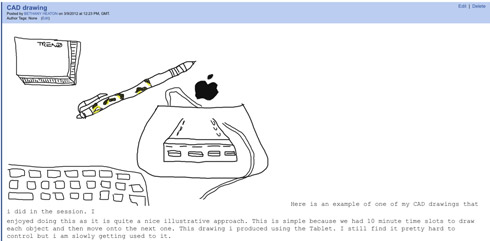
Figure 3

Figure 4
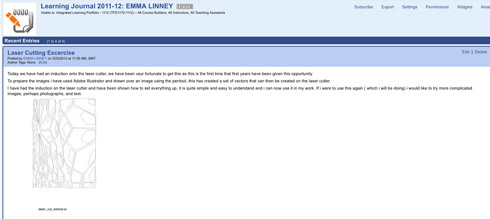
Figure 5

Figure 6
Evaluation
The delivery of theoretical and contextual studies, visual design research and digital resources came together through three specific routes: ‘themes of drawing’, ‘digital context’, and ‘blending the physical with the virtual’. These integrated projects gave students an opportunity to apply their knowledge and skills development across them and for different outcomes. It also provided staff with new and innovative ways to present a more holistic and shared approach to course content. Parallel links on specific themes such as ‘drawing lines within the urban landscape’, ‘creating shadow silhouettes’, ‘using the body as a tool for drawing’, and ‘cultivating fortuitous accidents in drawing practice’, created a space for students to actively experience and find new ways to make connections in their digital drawing. At the end of the year, the ILP reflective reports showed that students had a clearer sense of how they make informed connections across modules, as well as a means of establishing their own practice independently through these new teaching and learning approaches [See Table 3].
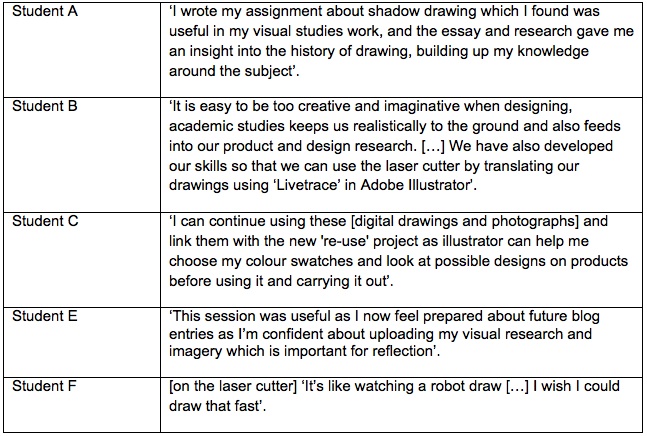
Table 3
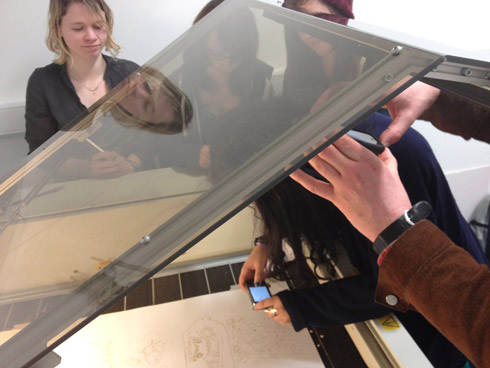
Figure 7
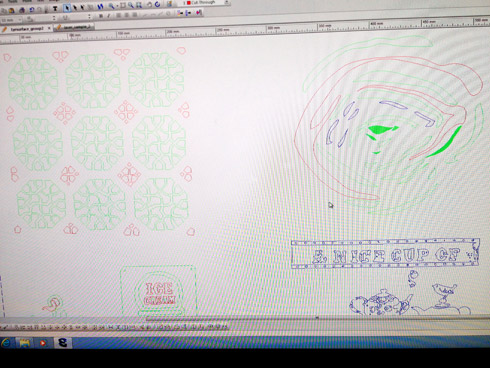
Figure 8
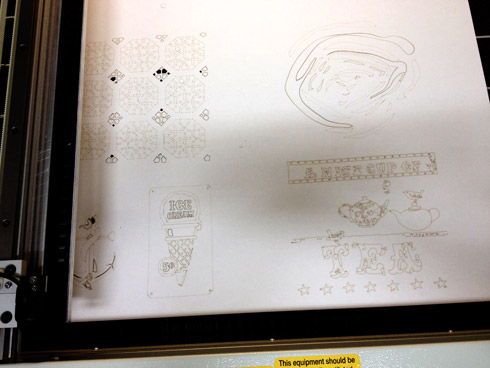
Figure 9
By definition drawing is an activity that happens in different modules or spaces, both digitally and physically. Digital drawing and hand drawing are neither isolated nor mutually exclusive practices. Quite the opposite, they are deeply complementary (Barron, 2008). This integrated approach to the ILP, at the level of content, made it possible for students to utilise, apply, improve and evolve their formal skills, as well their critical thinking through the relation between theory and practice across the programme as a whole.
Biographies
Dr Rowan Bailey is a Lecturer in Historical and Theoretical Studies and Academic Skills Tutor in the School of Art, Design and Architecture at the University of Huddersfield. She is a Fellow of the Higher Education Academy, and teaches theory and context modules in Textiles and Costume Design. Her current research interests include art school pedagogies, histories and theories of textile craft, and sculptural thinking. Her most recent article ‘Herder’s Sculptural Thinking’ (2011) in Parallax, Issue 59, April-June, pp.71-83, explores differing modes of thinking and making with the tools of sculpture in philosophical writing.
Andrew Taylor is a Senior Lecturer in the Department of Fashion & Textiles in the School of Art, Design and Architecture at the University of Huddersfield. Andrew’s research experiences inform and are integral to his art, design, and learning and teaching practice. His recent work explores experimental approaches to learning and teaching that attempts to make space for the diverse experiences and tacit skills of the learner through, and around the use of physical studio spaces, and 3D virtual interactive tools and virtual environments.
Linda Lewis is the Design Resource Coordinator, Learning Technologist and CAD/IT Demonstrating Technician in the School of Art, Design and Architecture at the University of Huddersfield. She manages the Trendhub blog (http://trendhub.wordpress.com/), and curates a broad collection of physical and on-line resources for trends and research within the creative industries.
References
Barron, E. (2008) ‘Drawing in the Digital Age’. In. Treib, M. Drawing/Thinking Confronting a Digital Age, London, New York. Routledge.
Cain, P. (2010) Drawing: The Enactive Evolution of the Practitioner, Bristol, Intellect.
Petherbridge, D. (2010) The Primacy of Drawing: Histories and Theories of Practice, London, Yale University Press.
Squires, P. Tinker, A. and Redmore, N. (2009) ‘Reflect, Understand and Plan: An Integrated Learning Portfolio’ In Conference Proceedings: Futurescan: Mapping the Territory, Association of Fashion and Textile Courses, Loughborough, pp.100-109.
Watkins, J. (1996) ‘Cold Dark Matter: An Exploded View’ In. Cameron, S. (Ed.) Cornelia Parker: Avoided Object, Cardiff, Art Data, pp.25-38.
Acknowledgments
Thank you to the student contributions within this paper and to the Textile Team for their contributions to curriculum design developments within the programme: Claire Barber, Sophie Calvert, Robert Clarke, Jo Harris, Nicola Perren, Nicola Redmore, Clair Sweeney and Matthew Taylor.
All images and tables supplied by the authors.
Figure 1: Digital drawing ‘live’ demonstration in Adobe Photoshop using Wacom Tablet
Figure 2: Student academic writing on selected shadow artists (History and Theory module) and Student Shadow Drawing of keys (Visual Research module)
Figure 3: Bethany Heaton Cad drawing reflection shown on learning journal blog
Figure 4: Emma Linney Adobe Illustrator drawing reflection on learning journal blog
Figure 5: Emma Linney reflection on laser cutting in learning journal blog
Figure 6: Briony Ramsden learning journal blog entry on creating colour swatches and pallets
Figures 7 - 9: Laser cutting workshop
Table 1: Template to show Areas of Learning within the ILP tool
Table 2: Content areas in Theory in Context mirrored in Visual Research
Table 3: Student Reflections in Reflective Blogs and ILP reports (2011-2012)
Listing image: section of Figure 1
Header image: section of Figure 7


